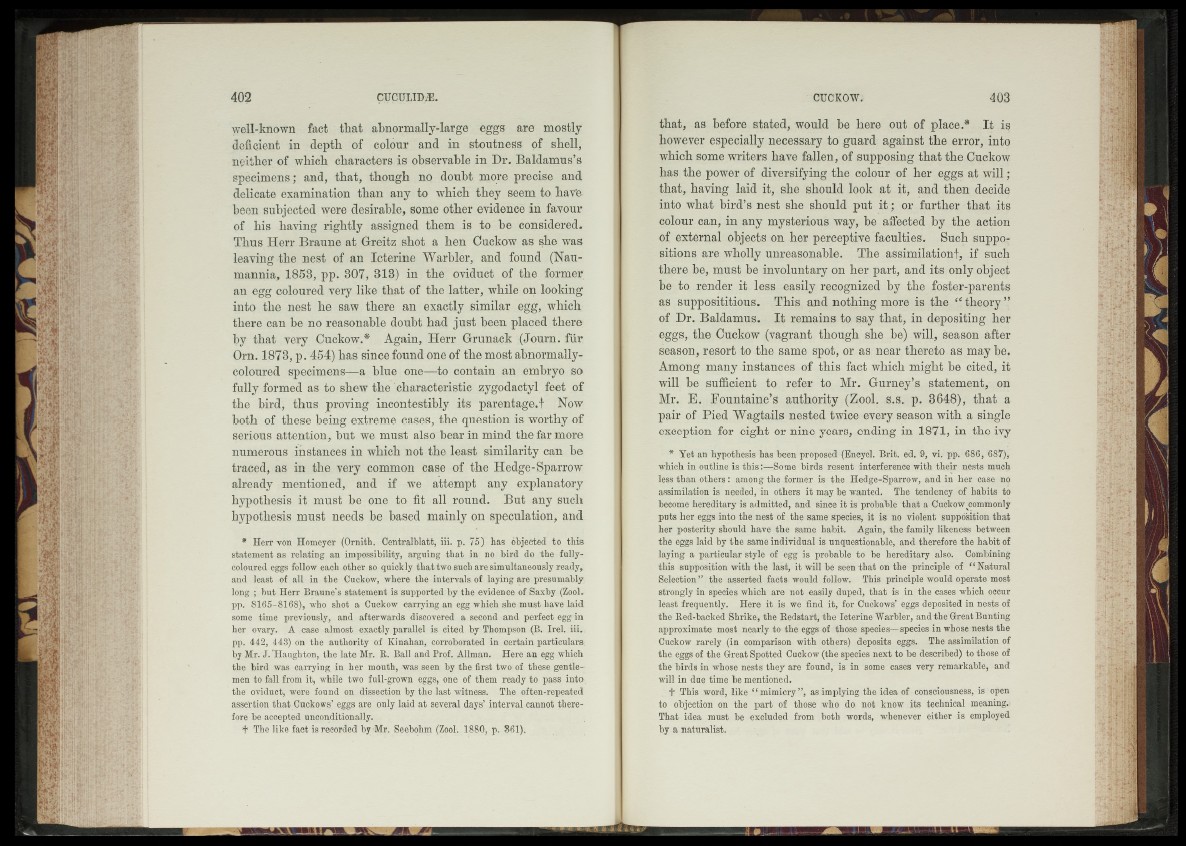
well-known fact that abnormally-large eggs are mostly
deficient in depth of colour and in stoutness of shell,
neither of which characters is observable in Dr. Baldamus’s
specimens; and, that, though no doubt more precise and
delicate examination than any to which they seem to hav'e-
been subjected were desirable, some other evidence in favour
of his having rightly assigned them is to be considered.
Thus Herr Braune at Greitz shot a hen Cuckow as she was
leaving the nest of an Icterine Warbler, and found (Nau-
mannia, 1853, pp. 307, 313) in the oviduct of the former
an egg coloured very like that of the latter, while on looking
into the nest he saw there an exactly similar egg, which
there can be no reasonable doubt had just been placed there
by that very Cuckow.* Again, Herr Grunack (Journ. fiir
Orn. 1873, p. 454) has since found one of the most abnormally-
coloured specimens—a blue one—to contain an embryo so
fully formed as to shew the characteristic zygodactyl feet of
the bird, thus proving incontestibly its parentage.! Now
both of these being extreme cases, the question is worthy of
serious attention, but we must also bear in mind the far more
numerous instances in which not the least similarity can be
traced, as in the very common case of the Hedge-Sparrow
already mentioned, and if we attempt any explanatory
hypothesis it must be one to fit all round. But any such
hypothesis must needs be based mainly on speculation, and
* Herr von Homeyer (Omith. Centralblatt, iii. p. 75) has objected to this
statement as relating an impossibility, argning that in no bird do the fully-
coloured eggs follow each other so quickly that two such are simultaneously ready,
and least of all in the Cuckow, where the intervals of laying are presumably
long ; but Herr Braune’s statement is supported by the evidence of Saxby (Zool.
pp. 8165-8168), who shot a Cuckow carrying an egg which she must have laid
some time previously, and afterwards discovered a second and perfect egg in
her ovary. A case almost exactly parallel is cited by Thompson (B. Irel. iii.
pp. 442, 443) on the authority of Kinahan, corroborated in certain particulars;
by Mr. J. Haughton, the late Mr. R. Ball and Prof. Allman. Here an egg which
the bird was carrying in her mouth, was seen by the first two of these gentlemen
to fall from it, while two full-grown eggs, one of them ready to pass into
the oviduct, were found on dissection by the last witness. The often-repeated
assertion that Cuckows’ eggs are only laid at several days’ interval cannot therefore
be accepted unconditionally.
■t The like fact is recorded by Mr. Seebohm (Zool. 1880, p. 861).
that, as before stated, would be here out of place.* It is
however especially necessary to guard against the error, into
which some writers have fallen, of supposing that the Cuckow
has the power of diversifying the colour of her eggs at will;
that, having laid it, she should look at it, and then decide
into what bird’s nest she should put it; or further that its
colour can, in any mysterious way, be affected by the action
of external objects on her perceptive faculties. Such suppositions
are wholly unreasonable. The assimilation!, if such
there be, must be involuntary on her part, and its only object
be to render it less easily recognized by the foster-parents
as supposititious. This and nothing more is the “ theory ”
of Dr. Baldamus. It remains to say that, in depositing her
eggs, the Cuckow (vagrant though she be) will, season after
season, resort to the same spot, or as near thereto as may be.
Among many instances of this fact which might be cited, it
will be sufficient to refer to Mr. Gurney’s statement, on
Mr. E. Fountaine’s authority (Zool. s.s. p. 3648), that a
pair of Pied Wagtails nested twice every season with a single
exception for eight or nine years, ending in 1871, in the ivy
* Yet an hypothesis has been proposed (Encyel. Brit. ed. 9, vi. pp. 686, 687),
which in outline is th is:—Some birds resent interference with their nests much
less than others : among the former is the Hedge-Sparrow, and in her case no
assimilation is needed, in others it may be wanted. The tendency of habits to
become hereditary is admitted, and since it is probable that a Cuckow ^commonly
puts her eggs into the nest of the same species, it is no violent supposition that
her posterity should have the same habit. Again, the family likeness between
the eggs laid by the same individual is unquestionable, and therefore the habit of
laying a particular style of egg is probable to be hereditary also. Combining
this supposition with the last, it will be seen that on the principle of “ Natural
Selection” the asserted facts would follow. This principle would operate most
strongly in species which are not easily duped, that is in the cases which occur
least frequently. Here it is we find it, for Cuckows’ eggs deposited in nests of
the Red-backed Shrike, the Redstart, the Icterine Warbler, and the Great Bunting
approximate most nearly to the eggs of those species—species in whose nests the
Cuckow rarely (in comparison with others) deposits eggs. The assimilation of
the eggs of the Great Spotted Cuckow (the species next to be described) to those of
the birds in whose nests they are found, is in some cases very remarkable, and
will in due time be mentioned.
d* This word, like “ mimicry”, as implying the idea of consciousness, is open
to objection on the part of those who do not know its technical meaning.!
That idea must be excluded from both words, whenever either is employed
by a naturalist.